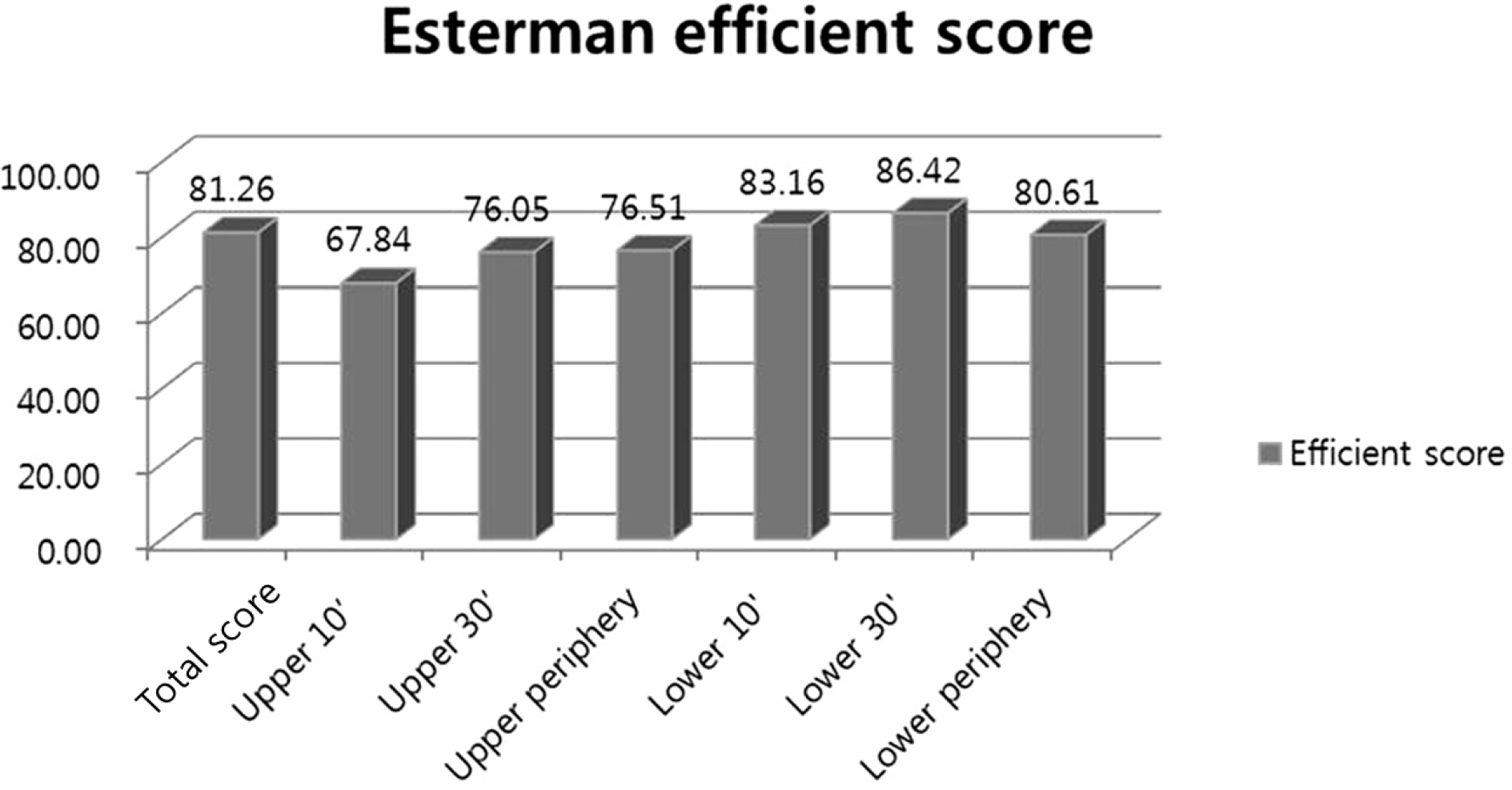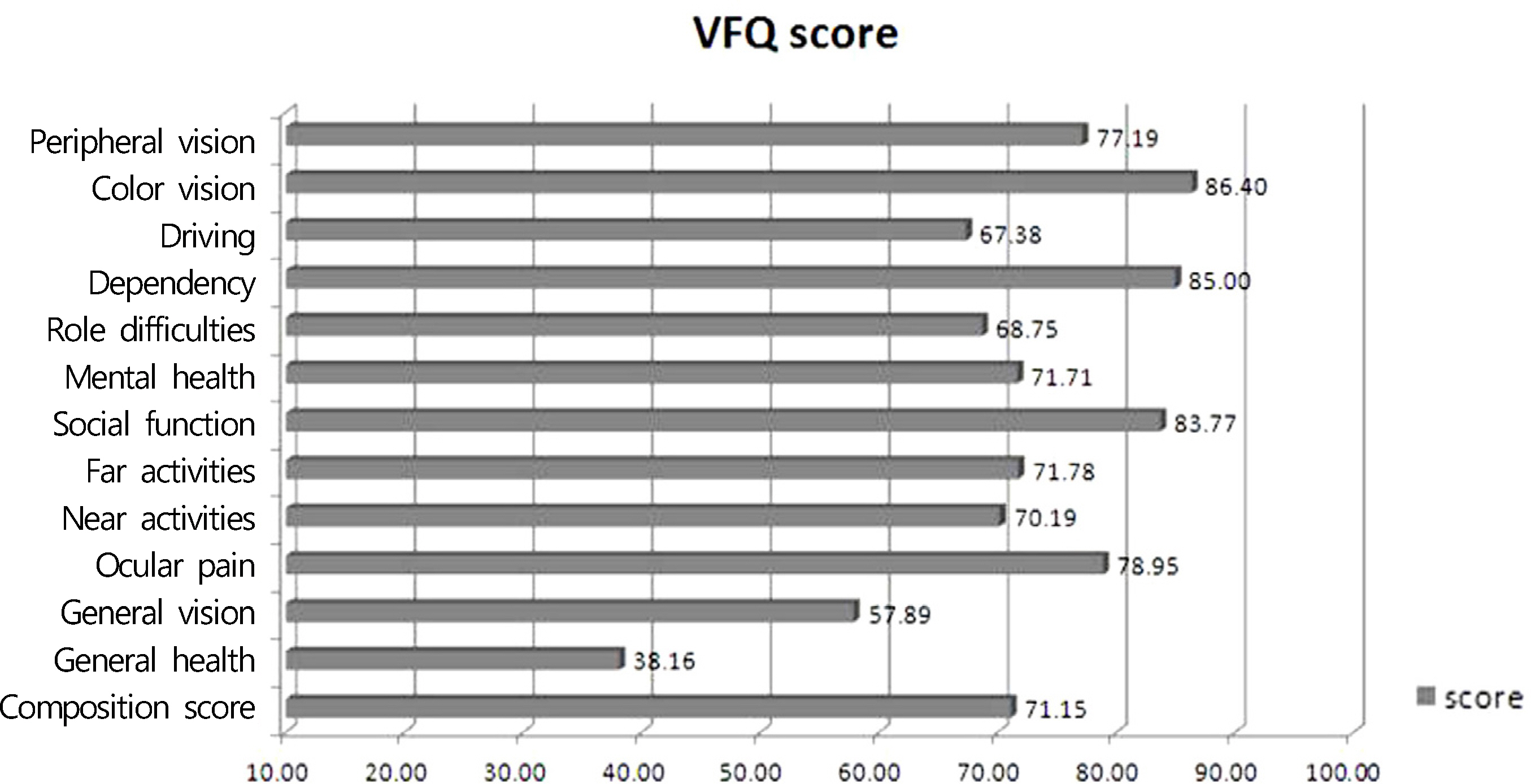J Korean Ophthalmol Soc.
2013 Oct;54(10):1567-1572.
Assessment of the Vision-Specific Quality of Life Using Binocular Esterman Visual Field in Glaucoma Patients
- Affiliations
-
- 1Department of Ophthalmology, Samsung Medical Center, Sungkyunkwan University School of Medicine, Seoul, Korea. ckee@skku.edu
Abstract
- PURPOSE
To investigate the correlation of binocular visual field (VF) with vision-specific quality of life in glaucoma patients.
METHODS
Sixty patients who were diagnosed as open-angle glaucoma were recruited for the present study. The patients had at least moderate VF defect in 1 eye. VF testing was performed using the unilateral Humphrey Field Analyzer (HFA) and binocular Esterman VF test which was divided into 6 clusters: upper and lower center 10', upper and lower center 30', and upper and lower periphery. The 25-item National Eye Institute Visual Function Questionnaire (VFQ) was used to evaluate patients' vision-specific quality of life. We analyzed the correlation between the efficiency score of each cluster from binocular Esterman VF test, mean deviation of HFA, and the scores of VFQ (Spearman correlation).
RESULTS
The correlation between the composition score of VFQ and total score of binocular Esterman visual field test was significant. The highest correlation was observed in the lower periphery cluster (all p < 0.05). For general vision, the lower center 10' visual field was strongly correlated (p = 0.011), and for driving, the upper peripheral visual field was the strongest correlated (p = 0.038). The level of mean deviation in the worse eye showed significant correlation with composition score of questionnaire (p = 0.008), otherwise the level of mean deviation in the better eye did not show any significant correlation (p > 0.05).
CONCLUSIONS
Binocular Esterman VF test is an easy and effective way to evaluate the vision-specific quality of life in glaucoma patients.
MeSH Terms
Figure
Reference
-
References
1. Gutierrez P, Wilson MR, Johnson C. . Influence of glaucomatous visual field loss on health-related quality of life. Arch Ophthalmol. 1997; 115:777–84.
Article2. Luini LP, Mastroberardino S, Marucci FS. Investigating spatial behaviour: an application of space analysis to criminal investigations. Cogn Process. 2009; 10(Suppl 2):S247–9.
Article3. Sawada H, Yoshino T, Fukuchi T, Abe H. Assessment of the vision-specific quality of life using clustered visual field in glaucoma patients. J Glaucoma. 2012; Jul 23. [Epub ahead of print].
Article4. Kolker AE. Visual prognosis in advanced glaucoma: a comparison of medical and surgical therapy for retention of vision in 101 eyes with advanced glaucoma. Trans Am Ophthalmol Soc. 1977; 75:539–55.5. Fujita K, Yasuda N, Oda K, Yuzawa M. [Reading performance in patients with central visual field disturbance due to glaucoma]. Nihon Ganka Gakkai Zasshi. 2006; 110:914–8.6. Jampel HD, Friedman DS, Quigley H, Miller R. Correlation of the binocular visual field with patient assessment of vision. Invest Ophthalmol Vis Sci. 2002; 43:1059–67.7. Kulkarni KM, Mayer JR, Lorenzana LL. . Visual field staging systems in glaucoma and the activities of daily living. Am J Ophthalmol. 2012; 154:445–51.e3.
Article8. Ryan B, Court H, Margrain TH. Measuring low vision service outcomes: Rasch analysis of the seven-item national eye institute visual function questionnaire. Optom Vis Sci. 2008; 85:112–21.
Article9. Anderson MD, Douglas R. Basis of quantitative perimetry. Kimberly Kist, editor. Automated static perimetry. 2nd ed.St Louis: Mosby;1997. chap. 2.10. Esterman B. Functional scoring of the binocular field. Ophthalmology. 1982; 89:1226–34.
Article11. Turano KA, Rubin GS, Quigley HA. Mobility performance in glaucoma. Invest Ophthalmol Vis Sci. 1999; 40:2803–9.12. Owsley C, Stalvey BT, Wells J. . Visual risk factors for crash involvement in older drivers with cataract. Arch Ophthalmol. 2001; 119:881–7.
Article13. Mills RP, Drance SM. Esterman disability rating in severe glaucoma. Ophthalmology. 1986; 93:371–8.
Article14. Nelson-Quigg JM, Cello K, Johnson CA. Predicting binocular visual field sensitivity from monocular visual field results. Invest Ophthalmol Vis Sci. 2000; 41:2212–21.15. Ayala M. Comparison of the monocular Humphrey Visual Field and the binocular Humphrey Esterman Visual Field test for driver licensing in glaucoma subjects in Sweden. BMC Ophthalmol. 2012; 12:35.
Article
- Full Text Links
- Actions
-
Cited
- CITED
-
- Close
- Share
- Similar articles
-
- Relationship between Binocular Visual Function and Quality of Life in Bilateral Normal Tension Glaucoma Patients
- Visual function and quality of life in Korean patients with glaucoma
- Path to Diagnosis and Clinical Characteristics of Advanced Glaucoma at Initial Diagnosis: a Tertiary Single Center Experience
- The Influence of Miotics on Visual Field in Glaucoma
- Quality of Life According to Location of Integrated Binocular Visual Field Defect in Normal-Tension-Glaucoma Patients




